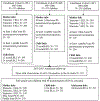Associations of prenatal and childhood Pb exposure with allostatic load in adolescence: Findings from the ELEMENT cohort study
- PMID: 37442254
- PMCID: PMC10839745
- DOI: 10.1016/j.envres.2023.116647
Associations of prenatal and childhood Pb exposure with allostatic load in adolescence: Findings from the ELEMENT cohort study
Abstract
The biological pathways which link lead (Pb) and long-term outcomes are unclear, though rodent models and a few human studies suggest Pb may alter the body's stress response systems, which over time, can elicit dysregulated stress responses with cumulative impacts. This study examined associations between prenatal and early childhood Pb exposure and adolescent allostatic load, an index of an individual's body burden of stress in multiple biological systems, and further examined sex-based associations. Among 391 (51% male) participants in the ELEMENT birth cohort, we related trimester-specific maternal blood Pb, 1-month postpartum maternal tibia and patella Pb, and child blood Pb at 12-24 months to an allostatic load index in adolescence comprised of biomarkers of cardiovascular, metabolic, neuroendocrine, and immune function. The results were overall mixed, with prenatal exposure, particularly maternal bone Pb, being positively associated with allostatic load, and early childhood Pb showing mixed results for males and females. In adjusted Poisson regression models, 1 mcg/g increase in tibia Pb was associated with a 1% change in expected allostatic load (IRR = 1.01; 95%CI 0.99, 1.02). We found a significant Pb × sex interaction (IRR = 1.05; 95%CI 1.01, 1.10); where males saw an increasing percent change in allostatic load as 12 month Pb levels increased compared to females who saw a decreasing allostatic load. Further examination of allostatic load will facilitate the determination of potential mechanistic pathways between developmental toxicant exposures and later-in-life cardiometabolic outcomes.
Keywords: Adolescent health; Allostatic load; Child exposure; Pb exposure; Physiological stress.
Copyright © 2023 Elsevier Inc. All rights reserved.
Conflict of interest statement
Declaration of competing interest The authors declare that they have no known competing financial interests or personal relationships that could have appeared to influence the work reported in this paper.
Figures
Similar articles
-
Prospective association between maternal allostatic load during pregnancy and child mitochondrial content and bioenergetic capacity.Psychoneuroendocrinology. 2022 Oct;144:105868. doi: 10.1016/j.psyneuen.2022.105868. Epub 2022 Jul 15. Psychoneuroendocrinology. 2022. PMID: 35853381 Free PMC article.
-
Preconception biomarkers of allostatic load and racial disparities in adverse birth outcomes: the Bogalusa Heart Study.Paediatr Perinat Epidemiol. 2013 Nov;27(6):587-97. doi: 10.1111/ppe.12091. Epub 2013 Oct 10. Paediatr Perinat Epidemiol. 2013. PMID: 24117472 Free PMC article.
-
Early life predictors of midlife allostatic load: A prospective cohort study.PLoS One. 2018 Aug 16;13(8):e0202395. doi: 10.1371/journal.pone.0202395. eCollection 2018. PLoS One. 2018. PMID: 30114237 Free PMC article.
-
Allostatic load: Developmental and conceptual considerations in a multi-system physiological indicator of chronic stress exposure.Dev Psychobiol. 2021 Jul;63(5):825-836. doi: 10.1002/dev.22107. Epub 2021 Mar 1. Dev Psychobiol. 2021. PMID: 33650132 Review.
-
Allostasis and allostatic load: expanding the discourse on stress and cardiovascular disease.J Clin Nurs. 2008 Apr;17(7B):201-8. doi: 10.1111/j.1365-2702.2008.02347.x. J Clin Nurs. 2008. PMID: 18578796 Review.
Cited by
-
The Impact of Arsenic, Cadmium, Lead, Mercury, and Thallium Exposure on the Cardiovascular System and Oxidative Mechanisms in Children.Curr Issues Mol Biol. 2025 Jun 25;47(7):483. doi: 10.3390/cimb47070483. Curr Issues Mol Biol. 2025. PMID: 40728952 Free PMC article. Review.
References
-
- Advisory Committee on Childhood Lead Exposure Prevention. Low Level Lead Exposure Harms Children: A Renewed Call for Primary Prevention. US Centers for Disease Control and Prevention. Accessed November 23, 2018. https://www.cdc.gov/nceh/lead/acclpp/final_document_030712.pdf.
-
- Aradillas-García C, Rodríguez-Morán M, Garay-Sevilla ME, Malacara JM, Rascon-Pacheco RA, Guerrero-Romero F, 2012. Distribution of the homeostasis model assessment of insulin resistance in Mexican children and adolescents. Eur. J. Endocrinol 166 (2), 301–306. 10.1530/EJE-11-0844, 01 Feb. 2012. - DOI - PubMed
-
- Centers for Disease Control and Prevention Work Group on Lead and Pregnancy, 2010. Guidelines for the Identification and Management of Lead Exposure in Pregnant and Lactating Women. https://www.cdc.gov/nceh/lead/prevention/pregnant.htm.
Publication types
MeSH terms
Substances
Grants and funding
- R24 ES028502/ES/NIEHS NIH HHS/United States
- L30 NR020943/NR/NINR NIH HHS/United States
- U24 ES028502/ES/NIEHS NIH HHS/United States
- R01 ES007821/ES/NIEHS NIH HHS/United States
- P01 ES022844/ES/NIEHS NIH HHS/United States
- R01 ES014930/ES/NIEHS NIH HHS/United States
- P30 ES017885/ES/NIEHS NIH HHS/United States
- P30 DK020572/DK/NIDDK NIH HHS/United States
- P30 DK089503/DK/NIDDK NIH HHS/United States
- R01 ES013744/ES/NIEHS NIH HHS/United States
- T32 ES007062/ES/NIEHS NIH HHS/United States
- R35 ES031686/ES/NIEHS NIH HHS/United States
LinkOut - more resources
Full Text Sources



